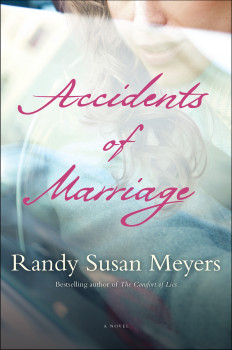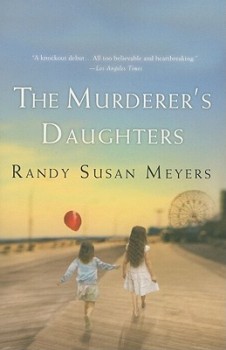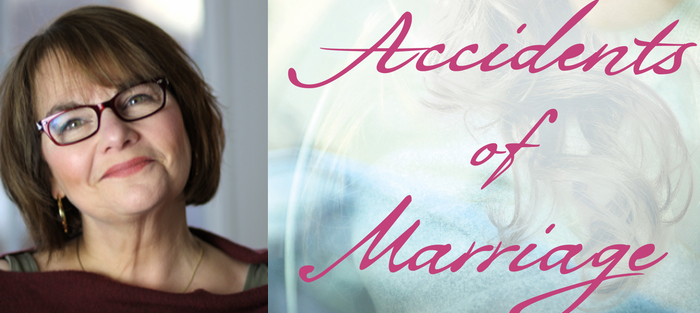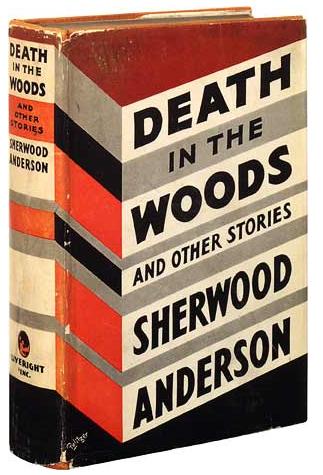I first met Randy Susan Meyers through Grub Street, where I took a seminar shortly after I moved to Boston and was sniffing the air for a community of writers. Randy had a certain gravitas in the class; it was late 2007 and she was well in the chute toward publishing her first novel, The Murderer’s Daughters (St. Martin’s Press, 2010). But what I learned after we became blogmates, writing-group colleagues, and friends, is that that novel was just the visible tip of a twenty-year, six-books-in-a-drawer iceberg. It was early evidence of a second career taking shape after decades as a social worker, a counselor to men who batter women, a bartender, and any number of other jobs undertaken in the course of raising two children as a divorced mum. I also learned that her writing critiques and knowledgeable commentary on craft were the result of a lengthy self-education she wryly calls her homemade MFA. I’ve quite simply never met a writer, or a professional anything, who so thoroughly worked at his or her own education in a field. But more importantly, I’m not sure I’ve ever met anyone else who shares that knowledge so generously with friends, colleagues, even the barest of acquaintances. Hello, Randy, can we have lunch so you can teach me about royalty statements? Yes. Jeez, I just can’t think of an epigram for my novel about 1800s vaudeville. Funny, I just remember reading this quote….
This month marks the release of her third novel, Accidents of Marriage (Atria Books), which has been pulling advance praise for its realistic portrayal of a verbally abusive marriage. But what I loved about it is what I love about all of Randy’s insightful, laser-like writing: an unflinching honesty toward her fallible characters—she refuses to gloss over the less attractive aspects of human nature—with wisdom and generosity of spirit. We spoke in early August, as publicity was geared up for this newest release.
Interview:
Nichole Bernier: First, let me say congratulations on your about-to-be-published, Acccidents of Marriage, with its shiny Kirkus star and Indie Next designation. How does it feel to have these accolades rolling in before it’s even hit the shelves?
Randy Susan Meyers: There’s no doubt that I’m thrilled and grateful. There’s also no doubt that I stay true to who I am: a trembling insecure person waiting for the one-stars; the Amazon one-star reviews will pierce the armor I’m busy building once again. Right now I’m knee-deep in pre-launch planning events and readings. The hardest part of launching a book is how it feels like you’re giving a wedding that you have to beg people to attend.
I have to tell you what I first loved about Accidents of Marriage. In the early pages, we glimpse your main character, Maddy, fingering a bag of Xanax squirreled away on a high shelf, and deciding how large a corner to bite off as evening comes on. That crackled on the page for me. It’s a hallmark of your style, that kind of telling detail, so much more effective than a self-pitying gush about the stress of husband and children. Do you hit that note naturally, or do you find yourself letting it all hang out in early drafts, then dialing back to a spare nugget? Because it’s about trusting the reader, isn’t it, to intuit the character’s mindset and environment from a snapshot of behavior?
 I use an uber-close p.o.v. with my characters, perhaps certifiably so. I work at entering them, writing them from the inside out. Everyone is the star of their own show—I want to convey characters using that self-involvement. Because of that, being so close to them, sometimes feeling as though I am them, I think I write a bit spare-nuggety from the beginning. I want to plunk the character onto the page and get inside her head. For instance, in Accidents of Marriage, if my main character is dreading her husband coming home from work, and it’s July, and she’s sweaty, and she’s sitting on a scratchy hot couch, what does she wish for? A cold shower? Being at the movies? Divorce? A Xanax?
I use an uber-close p.o.v. with my characters, perhaps certifiably so. I work at entering them, writing them from the inside out. Everyone is the star of their own show—I want to convey characters using that self-involvement. Because of that, being so close to them, sometimes feeling as though I am them, I think I write a bit spare-nuggety from the beginning. I want to plunk the character onto the page and get inside her head. For instance, in Accidents of Marriage, if my main character is dreading her husband coming home from work, and it’s July, and she’s sweaty, and she’s sitting on a scratchy hot couch, what does she wish for? A cold shower? Being at the movies? Divorce? A Xanax?
Being that close in prevents me from floating up and writing from above, or spiraling and getting lost back in time—I force myself to stay in the now as much as possible.
And yet you have an added challenge in this book’s point of view of writing through the lens of a traumatic brain injury. What drew you to this subject, and how did you go about getting “from the inside out” of that very specific compromised place?
I’m mystified by and marvel at all stories of conquering a hurdle, whether they be about mountains or medical emergencies. Woven into Accidents of Marriage is my desire to have concrete examples of how bad behavior engenders collateral damage—often way beyond our imaginings. People who rage rarely imagine the possible consequences, the costs they and others will pay. Plus, I’ve always worried about car accidents and trauma of all kind. What better way to face it than live it in print?
An amalgam of motivations led me in particular to traumatic brain injury as a topic: I am drawn to all stories medical. In another life (the one where I was better at math and science) I’d be a doctor. That’s my fantasy profession; this is my first novel where there isn’t a doctor as a main character. Traumatic brain injuries present the challenge of relearning behaviors, life, relationships with oneself and others—I wanted to see that challenge.
Memoirs were my secret weapon to getting inside the experience of both being a victim of TBI [Traumatic Brain Injury] and being a caretaker for someone in recovery. I read innumerable memoirs—every one I could find—and was fascinated by all of them. (I also, of course, read all the factual medical stuff, heard people speak about their experiences, and watched operations online.) I purchased workbooks and other materials that would be used by people with TBI and then used them as though I were my character.
After all that, after mixing in all the ingredients of research, the book had to be about that particular character with that problem, with that individuated challenge, that was important. In other words—I wasn’t writing as Maddy the TBI victim; I was writing as Maddy, a woman made up of all her individual skeins, who now faced life with traumatic brain injury. I didn’t want to make the injury the character, but have the character react to her injury.
And the character also very much has to exist in reaction to her difficult husband. Although your three novels are very different, they all deal in some ways with bad boys, or the fallout of men behaving badly. What’s the fascination? (Note I didn’t say attraction.)
Oh, believe me, my former real attraction to bad boys went deep and long. And then I worked with batterers, the zenith of bad boys (men, ordered by the courts, to the intervention program where I worked). Lessons came fast and furious: a “bad boy” isn’t edgy, exciting, or a bag of fun, he’s usually mean and selfish and looking out for number one—himself—all the time.
 Yet, they these men can also be charming and fun.
Yet, they these men can also be charming and fun.
Perhaps the lure of the bad boy is similar to the lure of climbing Mt. Everest. It feels so good to conquer it and get to the top—despite the pain of the descent. Unfortunately, you have to climb down and start all over again to get back up to that thrilling peak.
At their core, the batterers who were my clients were no different from the bad boys to whom I’d once been drawn. Working with them cured me of the bad boy thing. I wished I could share with every woman the experience of sitting in a circle with fifteen court-ordered-to-be-there bad boys, because at some point during the forty-two weeks they occupied that church basement chair, they let loose with some truth that revealed the dime-a-dozen ordinariness of bad boy behavior.
I write about bad boys in all their forms, but I also like to explore the fact that they aren’t stock characters: Bad Boys 101. They are often just guys making awful choices. Awful choices that can destroy a woman.
Bad boys know how to put the glitter out in the beginning. Few women fall in love with the abusive part of a bad boy—we fall for that funny, charming, attentive guy. Then, when the warning signs start, and we chafe against them, he’ll bring back that funny charmer. Or the sad “no one but you understands me” guy. And the “forgive me, this will never happen again—and I’ve never loved anyone like I love you” guy.
I wanted to get inside that guy and get inside the woman who lives with him. And the children that live with him. And see what it was like from all sides.
You did that so deeply in your first novel, The Murderer’s Daughters, told from the point of view of two sisters who’d been told at a young age never to open the door for daddy (their estranged father). Was that part of the motivation for that story—to pull the curtain back on the myth that children don’t know what’s really going on?
 A large part of the motivation for The Murderer’s Daughters was my frustration at society’s silence on “those left behind.” In newspaper stories about domestic homicide, we hear about Joe Jones killing Mary Jones, and that three children are left behind—but we never hear what comes of those children. Plus, too often we write off the children—thinking no good can ever come of their lives. In truth, though trauma often breeds trauma, it also breeds our nurses, social workers, police, and surgeons. We become strong at the broken places.
A large part of the motivation for The Murderer’s Daughters was my frustration at society’s silence on “those left behind.” In newspaper stories about domestic homicide, we hear about Joe Jones killing Mary Jones, and that three children are left behind—but we never hear what comes of those children. Plus, too often we write off the children—thinking no good can ever come of their lives. In truth, though trauma often breeds trauma, it also breeds our nurses, social workers, police, and surgeons. We become strong at the broken places.
Thus, I wanted to tell that story from as close a first-person point of view as possible (both sisters are told from their own first-person p.o.v.) so that the reader could only know what the sisters know and only live through their story. We are too often fascinated by the criminals more than the victims. Children are the invisible victims in domestic crimes and domestic disputes. That is one of the reasons that of the three point of view characters that there are in Accidents of Marriage, one is the teenage daughter, whose take on the family situation is unique to her.
Speaking about motivation for a story, I’d love to talk for a minute about motivation to write, period—that impulse to take a thought, a problem, an idea, a curiosity, and take it to the page. I’ve heard you speak many times about your love of libraries as a child growing up in Brooklyn, but you didn’t initially gravitate toward jobs related to writing. Can you pinpoint when you went from avid reader to writer?
I always loved writing (and reading), but for a long time I lacked the proper environment, outlook, education, encouragement, and self-confidence to pursue writing seriously. For instance, when I was in seventh grade, my mother was called in because my teacher thought I’d plagiarized a fiction assignment. My mother believed I was bright, but she was too overwhelmed to figure out how to help me find an outlet. Mom prevented me from getting in serious trouble—but I don’t think that teacher ever really believed her. Intellectual nurturing wasn’t the coin of my family or educational realm.
I wrote all the time, but it took me forever to learn how to put in the hard work needed to go from spark of talent to a well-revised and polished final product. It took me an even longer time to have the guts to bet on myself. I did co-author a nonfiction book in my twenties that was published to good reviews. However, my dream, my passion, was fiction. How long did it take to sell my debut novel from when I began writing fiction.
Twenty-plus years and six novels in a drawer. On my bookshelves are over ninety books on writing (not counting those borrowed or given away). I would never have said it back then, at my personal ground zero, but I’m happy that it worked out as it did. The Murderer’s Daughters was the right book for me to debut with. Had I sold any previous novel, I don’t think I would have ended up feeling as right as I did. As with a partner, when you have the right material, there’s a magic click, and you fall in love—whether it takes six books, or sixteen years on one book.
Writing is notoriously difficult to learn from someone else, let alone from books. Can you tell us a bit about the best of what you found in those books that became your homemade MFA? What worked, and what didn’t? What rang true?
While one can’t learn the ineffables of writing from the page or a person—voice, innate talent, insightful narrative—one can gain skill sets and learn tools. Like architecture or painting, one’s concept and talent requires more than paper and pen.
There isn’t a single book I regret reading. Those that didn’t speak to me still offered something. It’s important not to take any one book on writing as the final word on the subject. What I got from them in total was the importance of crafting and structuring novels with good bones. Books like Between the Lines (Writers Digest Books, 2006), by Jessica Morrell helped me build an awareness of theme versus story, versus premise. I became more aware of the differences between plot and story, of being certain of the through lines in my novel.
After reading book after book, I became a more analytical and critical reader of my own work and of other’s. I made and taped up a poster that reminded me to: Make Life Difficult for the Characters. Make them suffer!
I didn’t glue myself to Breaking Bad simply for the great acting; it’s Vince Gilligan’s superb writing that builds the tension that captured me week in, week out. Books on writing can help gain skills in these areas.
I wrote myself lessons learned from the books, to wedge them into my brain, including advice such as this one:
Characterization? Avoid thumbnails sketches and let character unfold before the reader. Don’t define everything the moment they come on stage, start with a bit of looks, and let character’s personality unfold before reader. Watch out for “looking in the mirror” descriptions. Have your characters misunderstand each other at times. Have them answer the unspoken question rather than the one asked aloud. Have them hedge, talk at cross-purposes, disagree, lie, sound human.
What’s going on with your character? Can we see her worries, fears, and hopes? How many? We seldom feel one thing at a time. Have you tried a little tenderness? Shown the characters vulnerability? Readers like vulnerability, but beware showing too much pain: readers dislike weakness and self-pity, show pain subtly and whenever possible, with humor.
What does your character(s) want? What’s the obstacle to the want? What action has your character taken to overcome the obstacles? Are things too easy for your characters—thus tamping down tension and conflict?
“Readers want to be haunted by characters.” — Jessica Morrell
It seems to me that the other half of your homemade MFA has been a homemade MBA in publishing. What would you say are your top 5 things writers need to know about their marketing and bottom line?
The research I’ve done is the result of my incredible neurosis. I can’t put my life, my career, blindly in the hands of others. Learning about the business end of publishing and writing was and is my way of being able to participate in how my work gets to market. Five things:
1. Learn how to read your royalty statements. And then read them, damn it! It’s amazing how many writers say they never read them. There are errors in them, folks. For instance, the “laddering” payment percentages can be wrong (by laddering, I mean the manner in which one’s royalty amounts increase with each X thousand books sold—just one example).
2. Find out and understand your marketing plan. See where you can work with the publisher to increase the usefulness. Learn what the writing on the back of your ARC [Advance Reader Copy] means!
3. Keep track of everything you do for your book: Keep book club addresses. Write down everyplace your book is reviewed. Keep a list of every bookstore you speak at, every event you do, every library you visit. When your second and third books are released, you will be grateful you did this.
4. Ask what and where your sales orders are. This can help you plan your marketing. It might be more useful to focus laser-narrow for marketing.
5. Track (you can do this on Amazon’s Author Central) the geographic rank of your book sales. This will help you plan marketing strategies with your publisher.
Also, read books about the business end of the business. The Forest for the Trees (Riverhead, 2000), by Betsy Lerner, is like an instant shrink for writers. I co-authored What to Do Before Your Book Launch (Argo-Navis, 2012) with M.J. Rose to help writers plan their publicity and marketing and to know what to expect from publishers.
Before we wrap up, let’s talk for a minute about “late blooming” vs. bolting out of the gate all young and leggy. It has always struck me as bizarre to apply the cult-of-youth mentality to honoring artists—the top 20 under 40 lists—because there are so many factors in the nature and nurture camps: style, skill, chutzpah, determination, economics, connections. I love your round-up of authors who debut over forty. What do you think is the difference between those “born naturals” who come to success and recognition young, and the so-called overnight successes at sixty? (I love when Barbara Shapiro waxes poetic about that in her book talks, the fact that she leapt as a sudden sensation onto the New York Times bestseller list, never mind that she’d published lesser known novels for years.)
I actually doubt that any “born naturals” who leap onto the scene truly began with that particular book (unless they are a screen/music star or a child of the famous). It’s more likely they were particularly driven and have been writing practice books since they were ten years old.
Truly, there’s room for both sorts of writers: those who gestate thoughts and talent for sixty years and those who burst onto the page at twenty-one. So many things go into ultimate success—raw talent, ability to concentrate, giving up “fun,” having to attend to family, drive, love, money (if you have to support yourself and your family, time is short)—that age becomes simply one of the factors.
On the other hand, worshipping writers for their youth or their sexy author photo seems an odd paradigm for an art form that is between reader and words on the page. Why care how cute the author is? How unwrinkled? How does this affect one’s relationship with reading?
That said, I do have a prejudice. I believe all good books (whatever the genre or topic) hold emotional resonance from author’s lives, and we all need a bit of distance before we write about events (whether factual or not) that hold hot immediacy for us.
Can I ask if you’re working on anything new you’d care to share? That seems like a thoroughly unfair question when a person’s next book hasn’t even quite come out, but I know you are, you workhorse you.
I actually have two (okay, three) topics I am exploring in fiction, but they are far too nascent to write about publicly at this stage! Lets just list hot points: Obsessions with weight, with truth, scandal, and communes.






